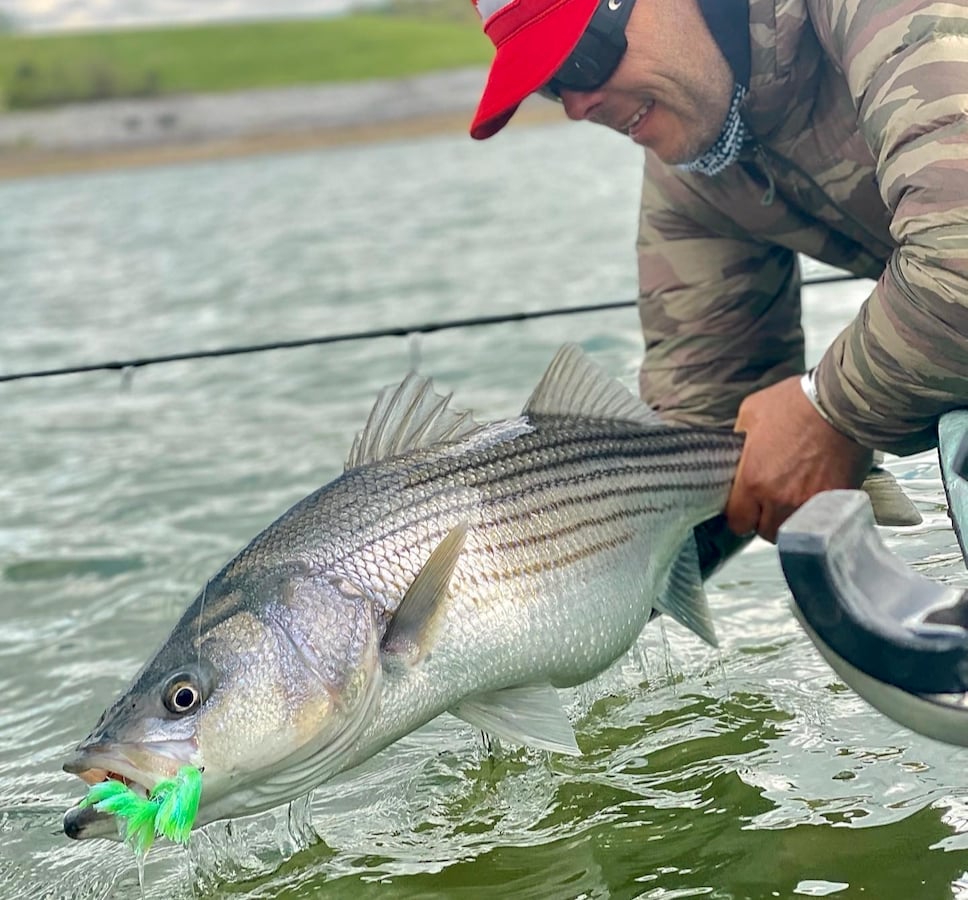Answer: Sweet water stripers can offer a taste of that wild saltwater action so many of us landlocked anglers crave. The explosive strikes and reel-burning runs of lake and river dwelling silver-sided brutes can rival that of their coastal cousins, making freshwater stripers one of the most thrilling fly rod pursuits in inland waters.
Floating, sinking, sink-tip, and intermediate lines should all be part of your arsenal paired up with 8-, 9-, and even 10-weight rods. These are potentially big fish (30-pounders are not uncommon) and you’ll be throwing husky flies often in open water. The last thing you’ll want is the sad and frantic realization that you are undergunned when a whopper decides to torpedo for the far side of the lake.
Freshwater striped bass prey mostly on shad, herring, and other baitfish. A well-stocked fly box should include a variety of patterns designed to imitate them. Matching the hatch is also key for freshwater stripers. While their saltwater cousins tend to smash and grab anything when they’re all spun up, freshwater stripers are a more discerning bunch. Sometimes the difference between a fine day and getting skunked comes down to a one inch difference in what size fly you’re throwing. As with all angling, really any outdoor pursuit, astute observation is key. Watch the water for baitfish activity noting length and species if possible. Then tie in your closest approximation and let ‘er rip.
The Clouser: A Time-Tested Favorite
When targeting trophy stripers, the Clouser Deep Minnow stands out as a go-to pattern. Since Bob Clouser first introduced it, this versatile fly has been a consistent producer. A well-stocked fly box should include a variety of colors, with chartreuse and white being particularly effective. The Clouser’s ability to imitate a wide range of baitfish makes it an essential tool for any serious striper angler.
The Bush Pig: An Unexpected Hero
While less well-known, the Bush Pig has proven its worth in the striper fishing world. Originally designed for exotic species, this full-bodied fly has a knack for triggering aggressive strikes from even the most lethargic stripers. On days when other patterns fail to produce, a slow-stripped Bush Pig can entice charges from the depths.
Topwater Tactics: The Gurgler’s Charm
Surface action brings an added dimension of excitement to striper fishing. On calm evenings, when feeding fish can be heard slurping at the surface, the Gurgler comes into its own. The key to success lies in the retrieve—a series of quick strips followed by a pause can drive stripers into a frenzy. It’s not uncommon to see fish traveling significant distances to attack a well-presented Gurgler.
The Whistler: Ace in the Hole
Challenging conditions call for specialized tools, and the Whistler excels when water clarity is less than ideal. This fly’s water-pushing design creates vibrations that stripers can home in on even in murky conditions. During periods of high, stained water, such as spring runoff, the Whistler can turn an otherwise tough day into a productive outing.
The Deceiver: A Timeless Classic
The Deceiver has earned its place as a classic pattern in the striper fly box. Its ability to imitate a range of baitfish, from small minnows to hefty herring, makes it a versatile choice across various conditions. Tying Deceivers sparsely for clear water and more robustly for reduced visibility allows anglers to adapt to changing conditions on the water.
The Game Changer: Revolutionary Articulation
No discussion of modern striper flies would be complete without mentioning Blane Chocklett’s revolutionary Game Changer. The Game Changer’s segmented body provides a lifelike swimming action that drives predatory fish, including stripers, into a feeding frenzy. What sets the Game Changer apart is its uncanny ability to imitate a wide range of forage fish. From shad to herring, this fly can be tied to match the hatch with stunning accuracy. The pattern’s jointed construction allows for fluid, serpentine movements in the water, mimicking the desperate escape of a wounded baitfish—a sight few stripers can resist.
Reading the Water: Thinking Like a Predator
Successful striper fishing goes beyond fly selection; it requires understanding the fish’s behavior and habitat preferences. Stripers are constantly on the move, following bait and utilizing structure to their advantage. Current seams, where fast water meets slow, often prove to be productive areas. These spots act as natural feeding lanes, allowing stripers to conserve energy while easily ambushing prey swept along by the current.
The Magic Hours: Dawn and Dusk
The importance of fishing during low-light periods cannot be overstated. Early mornings and late evenings often provide the best opportunities for encountering actively feeding stripers. During these twilight hours, big stripers frequently venture into shallower waters to hunt, offering anglers the chance to target them more effectively.
As with most angling, patience and persistence are important elements in the pursuit of stripers on the fly. These fish can exhibit maddeningly selective behavior one moment and voracious feeding the next. It’s this unpredictability, combined with the challenge and anticipation of the hunt, that continues to draw anglers to the sport.

